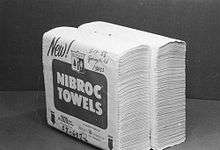Paper towel
A paper towel is an absorbent, disposable towel made from paper.[1] In Britain, paper towel for kitchen use is also known as kitchen roll, kitchen paper, kitchen towel, and poly roll.[2] For home use, it usually sold in a roll of perforated sheets, but some are sold in stacks of pre-cut and pre-folded layers for use in paper-towel dispensers. Unlike cloth towels, paper towels are disposable and intended to be used only once. Paper towels soak up water because they are loosely woven which enables water to travel between the fibers, even against gravity (capillary effect). Paper towels have similar purposes to conventional towels, such as drying hands, wiping windows and other surfaces, dusting and cleaning up spills. Paper towel dispensers are often used in toilets shared by many people, as paper towels are often considered more hygienic than hot-air hand dryers[3] (and, of course, shared cloth towels).

History

In 1907, the Scott Paper Company of Philadelphia, Pennsylvania, introduced paper tissues to help prevent the spread of colds from cloth towels in restrooms.[4] Popular belief is that this was partly accidental and was the solution to a railroad car full of long paper rolls meant for toilet paper that were unsuitable to cut into such.[5] In 1919, William E. Corbin, Henry Chase, and Harold Titus began experimenting with paper towels in the Research and Development building of the Brown Company in Berlin, New Hampshire.[6] By 1922, Corbin perfected their product and began mass-producing it at the Cascade Mill on the Berlin/Gorham line.[7] This product was called Nibroc Paper Towels (Corbin spelled backwards[8]). In 1931, the Scott Paper Company of Philadelphia, Pennsylvania, introduced their paper towel rolls for kitchens. In 1995, Kimberly-Clark acquired Scott Paper Company.
Production
Paper is made from either virgin or recycled paper pulp[9] which is extracted from wood or fiber crops. They are sometimes bleached during the production process to lighten the paper's coloration.[10] It is not uncommon for rolls of paper towels to include intricate colored images on each square (such as flowers or teddy bears). Resin size is used to improve the wet strength.[10] Paper towels are packed individually and sold as stacks, or are held on a continuous roll, and come in two distinct classes: domestic and institutional.[11] Many companies produce paper towels. Some of which include, but are not limited to: Bounty, Seventh Generation, Scott, and Viva, among many others.
Market
Tissue products in North American, including paper towels, can be divided into "consumer market consumer" and "commercial" markets, with household consumer usage accounting for approximately two thirds of total North American consumption.[11] Commercial usage, or otherwise any use outside of the North American household, accounts for one third of North American consumption.[11] The growth in commercial use of paper towels can be attributed to the migration from folded towels (in public bathrooms, for example) to roll towel dispensers, which reduces the amount of paper towels used by each patron.[11]
Within the forest products industry, paper towels are a major part of the "tissue market", second only to toilet paper.[11]
Americans are, by far, the highest users of paper towels in the home, compared to the people in any other country.[12] Consumption of paper towels and other tissue products is highest in the United States of America at approximately 24 kilograms (53 lb) per capita and year (total approx. 7.8 million tonnes (7,700,000 long tons; 8,600,000 short tons) per year), 50% higher than in Europe and nearly 500% higher than in Latin America.[11] By contrast, people in the Middle East tend to prefer reusable cloth towels, and people in Europe tend to prefer reusable cleaning sponges.[12]
Paper towels are popular primarily among people who have disposable income, so their use is higher in wealthy countries and low in developing countries.[12]
Environmental issues
Paper towels are a global product with rising production and consumption.[13] Being second in tissue consumption only to toilet paper (36% vs. 45% in the U.S.), the proliferation of the mostly non-recyclable paper towels has the same globally adverse effects on the environment as indicated in the tissue article.[14] However, paper towels made from recycled paper do exist, and are sold at many outlets.
Other better alternatives are conventional towels or, for hand drying, hand dryers.[15][16] Paper towels are quicker than hand dryers: after only ten seconds, paper towels achieve 90% dryness. Hot air dryers, on the other hand, take 40 seconds to achieve a similar dryness.[17]
See also
References
- "Paper towels may be more hygienic than air dryers - NHS". NHS. June 2013. Retrieved 14 January 2019.
- "Learn about Scott® Community and Scott® Brand".
- "The history of paper towel".
- "It felt like death". Archived from the original on July 17, 2011. Retrieved December 30, 2011.
- "Once Upon a Berlin Time". Archived from the original on September 26, 2013. Retrieved December 30, 2011.
- "Beginnings of the Cascade Paper Mill" (PDF). Archived from the original (PDF) on April 21, 2012. Retrieved December 30, 2011.
- "Frequently Asked Questions". quickerpickerupper.com. Archived from the original on 2007-06-09. Retrieved 2007-06-28.
- Sasser, Sue Lynn. Paper Towels Archived 2006-09-06 at the Wayback Machine from the Texas A&M website. Retrieved on June 29, 2007
- Brad Kalil, Director of Tissue (October 2008). "Tissue market continues to grow". Pulp & Paper Int'l Digital Edition. RISI. Archived from the original on 2008-12-16. Retrieved 2009-10-31.
- Pinsker, Joe (2018-12-10). "Americans Are Weirdly Obsessed With Paper Towels". The Atlantic. Retrieved 2018-12-11.
- "Guidelines to choosing best paper towels". 16 August 2015. Retrieved 29 August 2017.
- Jingshi Wu. "Taking Paper Towels to the Compost Pile: Nitty-gritty". Stanford Magazine.
- "Wait paper towels really come from trees?". growingagreenfamily.com. 2010-06-08.
- "How much tissue paper does an American household use in a day?". www.innovateus.net. Retrieved 29 August 2017.
- "Paper Towels – What's the Big Deal Anyway?". Ocean Currents. Retrieved 2017-03-06.